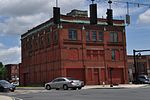Stagg Field (Springfield College)
Stagg Field is an athletic field on the campus of Springfield College in Springfield, Massachusetts. With bleacher seating for 3,867, is it the home field for Springfield College's football, field hockey, and men's and women's lacrosse team. It is also used for physical education classes and intramural sports. The Springfield College men's and women's soccer teams formerly played on the field. Featuring the first Astroturf12 surface in the nation to be installed on a college playing field, it is plowable and used year-round. The field is lighted according to National Collegiate Athletic Association (NCAA) standards for night games and has a heated and air conditioned press box.The field open in 1971 as Benedum Field. It was renamed in October 2007 in honor of Amos Alonzo Stagg, who came to Springfield College—then known as then known as International YMCA Training School—and initiated the school's football program. The field was resurfaced with "monofilament FieldTurf" during the summer of 2007.Stagg Field stands on the site of the college's previous athletics stadium, Pratt Field.
Excerpt from the Wikipedia article Stagg Field (Springfield College) (License: CC BY-SA 3.0, Authors).Stagg Field (Springfield College)
Conklin Street, Springfield
Geographical coordinates (GPS) Address Nearby Places Show on map
Geographical coordinates (GPS)
| Latitude | Longitude |
|---|---|
| N 42.105498 ° | E -72.553867 ° |
Address
Springfield College
Conklin Street
01108 Springfield
Massachusetts, United States
Open on Google Maps






